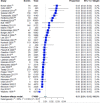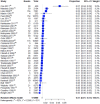Early Versus Delayed Stroke After Cardiac Surgery: A Systematic Review and Meta-Analysis
- PMID: 31215306
- PMCID: PMC6662344
- DOI: 10.1161/JAHA.119.012447
Early Versus Delayed Stroke After Cardiac Surgery: A Systematic Review and Meta-Analysis
Abstract
Background Although it is traditionally regarded as a single entity, perioperative stroke comprises 2 separate phenomena (early/intraoperative and delayed/postoperative stroke). We aimed to systematically evaluate incidence, risk factors, and clinical outcome of early and delayed stroke after cardiac surgery. Methods and Results A systematic review ( MEDLINE , EMBASE , Cochrane Library) was performed to identify all articles reporting early (on awakening from anesthesia) and delayed (after normal awakening from anesthesia) stroke after cardiac surgery. End points were pooled event rates of stroke and operative mortality and incident rate of late mortality. Thirty-six articles were included (174 969 patients). The pooled event rate for early stroke was 0.98% (95% CI 0.79% to 1.23%) and was 0.93% for delayed stoke (95% CI 0.77% to 1.11%; P=0.68). The pooled event rate of operative mortality was 28.8% (95% CI 17.6% to 43.4%) for early and 17.9% (95% CI 14.0% to 22.7%) for delayed stroke, compared with 2.4% (95% CI 1.9% to 3.1%) for patients without stroke ( P<0.001 for early versus delayed, and for perioperative stroke, early stroke, and delayed stroke versus no stroke). At a mean follow-up of 8.25 years, the incident rate of late mortality was 11.7% (95% CI 7.5% to 18.3%) for early and 9.4% (95% CI 5.9% to 14.9%) for delayed stroke, compared with 3.4% (95% CI 2.4% to 4.8%) in patients with no stroke. Meta-regression demonstrated that off-pump was inversely associated with early stroke (β=-0.009, P=0.01), whereas previous stroke (β=0.02, P<0.001) was associated with delayed stroke. Conclusions Early and delayed stroke after cardiac surgery have different risk factors and impacts on operative mortality as well as on long-term survival.
Keywords: cardiac surgery; delayed stroke; early stroke; stroke.
Figures





References
-
- Selnes OA, Goldsborough MA, Borowicz LM, McKhann GM. Neurobehavioural sequelae of cardiopulmonary bypass. Lancet. 1999;353:1601–1606. - PubMed
-
- Farkouh ME, Domanski M, Sleeper LA, Siami FS, Dangas G, Mack M, Yang M, Cohen DJ, Rosenberg Y, Solomon SD, Desai AS, Gersh BJ, Magnuson EA, Lansky A, Boineau R, Weinberger J, Ramanathan K, Sousa JE, Rankin J, Bhargava B, Buse J, Hueb W, Smith CR, Muratov V, Bansilal S, King S, Bertrand M, Fuster V; FREEDOM Trial Investigators . Strategies for multivessel revascularization in patients with diabetes. N Engl J Med. 2012;367:2375–2384. - PubMed
-
- Head SJ, Milojevic M, Daemen J, Ahn J‐M, Boersma E, Christiansen EH, Domanski MJ, Farkouh ME, Flather M, Fuster V, Hlatky MA, Holm NR, Hueb WA, Kamalesh M, Kim Y‐H, Mäkikallio T, Mohr FW, Papageorgiou G, Park S‐J, Rodriguez AE, Sabik JF, Stables RH, Stone GW, Serruys PW, Kappetein AP. Stroke rates following surgical versus percutaneous coronary revascularization. J Am Coll Cardiol. 2018;72:386–398. - PubMed
-
- Serruys PW, Morice M‐C, Kappetein AP, Colombo A, Holmes DR, Mack MJ, Ståhle E, Feldman TE, van den Brand M, Bass EJ, Van Dyck N, Leadley K, Dawkins KD, Mohr FW; SYNTAX Investigators . Percutaneous coronary intervention versus coronary‐artery bypass grafting for severe coronary artery disease. N Engl J Med. 2009;360:961–972. - PubMed
Publication types
MeSH terms
LinkOut - more resources
Full Text Sources
Medical

